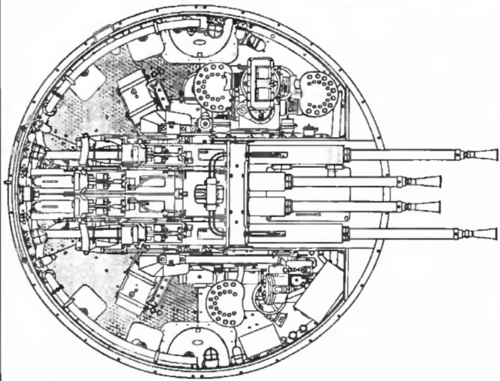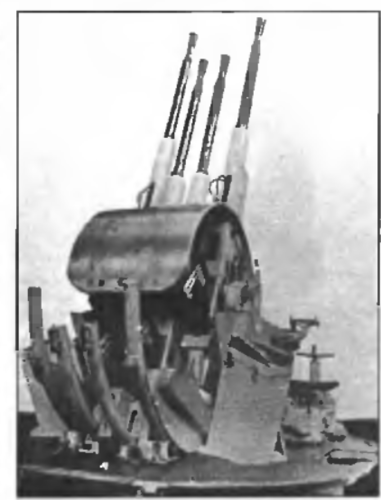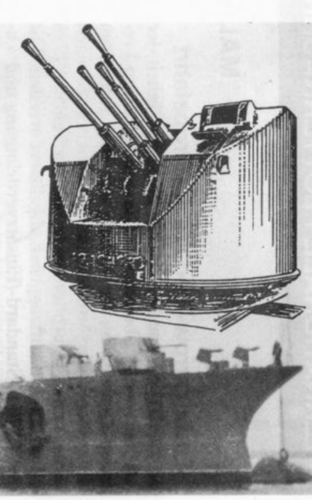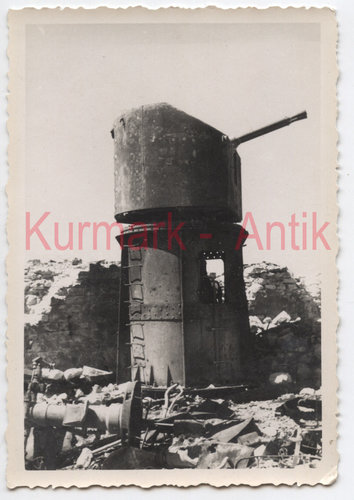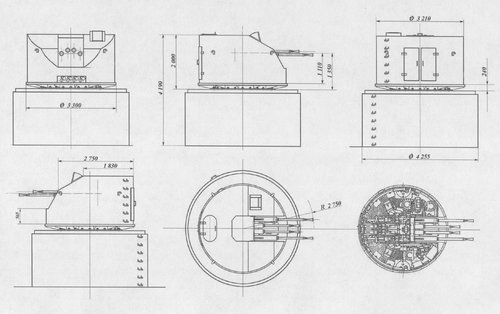One of my personal favorites, the 46-K quadruple 37mm AA mount, intend for the Sovetsky Soyuz-class battleships as well as the Kronshtadt-class battlecruisers. Does anyone know more about this interesting item? The first two images were taken from Alexander Shirokorad`s encyclopedia on russian and soviet artillery, the last one from Siegfried Breyer`s "Stalins Dickschiffe".
You are using an out of date browser. It may not display this or other websites correctly.
You should upgrade or use an alternative browser.
You should upgrade or use an alternative browser.
Soviet 46-K 37mm AA Quad mount
- Thread starter Wurger
- Start date
It`s little sister, taken from :
Post #237. The trunk seems to be original. Is there an enthusiast on soviet naval artillery?
Post #237. The trunk seems to be original. Is there an enthusiast on soviet naval artillery?
Attachments
I know something about it, but had not heard of the quad mount, which I presume never saw service. My take on the Russian 37 mm AA (from my forthcoming book on automatic cannon and their ammunition):
37 mm M1939: 37 x 252SR ammunition (aka 37 x 250R or SR).
This gun and its ammunition were designed at short notice in 1938 when it was felt that the 45 mm M1939 was too large; this 37 mm gun, designated ZIK-37 or 61-K, is effectively a scaled-down version of the 45 mm and is therefore a slightly smaller version of the 40 mm Bofors M32. It was fed via 5-round vertical clips and fired at 160-170 rpm. A twin-barrelled version of the wheeled land mounting was also made as the 47-V, but this saw more export sales than Russian service; the SU-37 SPAAG also saw only limited service. Nearly 20,000 army guns were produced by the end of WW2, after which Russian production ceased.
The appearance of the M39, with the boxy receiver and vertical feed, is very close to that of the German naval 3,7 cm Flak C/36 and Flak M42. Presumably all of these weapons were based on the Bofors system but the exact development relationship is unclear. The 37 mm M39 was developed with remarkable speed; possibly the Russians already had detailed information about the Flak C/36, as Germany provided various weapons for the Russians to evaluate.
Naval versions of the gun were designated as follows: 70-K (single barrel, air-cooled) over 3,000 made between 1941 and 1956); 66-K (twin barrels, water-cooled) prototype only, cancelled in favour of; V-11 (twin-barrelled, water-cooled, stabilised mounting) and V-11M (improved sights) of which 1,300 were made from 1944 to the early 1980s.
These weapons were widely sold abroad, and were made in large numbers by China. They remain in service in various countries, in some cases with upgrades to the mounting and/or fire control system; most recently in Pakistan, with 700 delivered.
37 mm M1939: 37 x 252SR ammunition (aka 37 x 250R or SR).
This gun and its ammunition were designed at short notice in 1938 when it was felt that the 45 mm M1939 was too large; this 37 mm gun, designated ZIK-37 or 61-K, is effectively a scaled-down version of the 45 mm and is therefore a slightly smaller version of the 40 mm Bofors M32. It was fed via 5-round vertical clips and fired at 160-170 rpm. A twin-barrelled version of the wheeled land mounting was also made as the 47-V, but this saw more export sales than Russian service; the SU-37 SPAAG also saw only limited service. Nearly 20,000 army guns were produced by the end of WW2, after which Russian production ceased.
The appearance of the M39, with the boxy receiver and vertical feed, is very close to that of the German naval 3,7 cm Flak C/36 and Flak M42. Presumably all of these weapons were based on the Bofors system but the exact development relationship is unclear. The 37 mm M39 was developed with remarkable speed; possibly the Russians already had detailed information about the Flak C/36, as Germany provided various weapons for the Russians to evaluate.
Naval versions of the gun were designated as follows: 70-K (single barrel, air-cooled) over 3,000 made between 1941 and 1956); 66-K (twin barrels, water-cooled) prototype only, cancelled in favour of; V-11 (twin-barrelled, water-cooled, stabilised mounting) and V-11M (improved sights) of which 1,300 were made from 1944 to the early 1980s.
These weapons were widely sold abroad, and were made in large numbers by China. They remain in service in various countries, in some cases with upgrades to the mounting and/or fire control system; most recently in Pakistan, with 700 delivered.
These are the most interesting mounts for me. How were they supposed to be stabilised?Naval versions of the gun were designated as follows: 70-K (single barrel, air-cooled) over 3,000 made between 1941 and 1956); 66-K (twin barrels, water-cooled) prototype only, cancelled in favour of; V-11 (twin-barrelled, water-cooled, stabilised mounting) and V-11M (improved sights) of which 1,300 were made from 1944 to the early 1980s
- Joined
- 1 February 2011
- Messages
- 2,802
- Reaction score
- 3,166
The V-11 and 11M twin mounting:

 ru.wikipedia.org
ru.wikipedia.org

I don't know how stabilization works for these
В-11 — Википедия

I don't know how stabilization works for these
There are two different approaches to gun stabilisation (both of them relying on gyro sensors, I think). The first and original type has the entire gun mounting on a tilting platform on board ship; this was used in WW2-era naval systems (usually multi-barrel), like the Bofors twin, and the Breda 20 mm and 37 mm twin mountings. This was cumbersome and required a lot of power because the entire mounting had be moved about. The modern approach is to leave the mounting attached to the ship, and adjust the gun training and elevation to compensate for ship movement.
- Joined
- 1 February 2011
- Messages
- 2,802
- Reaction score
- 3,166
You can find photos of the 37mm Twin mounting aka the Soviet Bofors:


Детали вооружения и оборудования [3] (61/215) [Форумы Balancer.Ru]
нужна помощь: фото конической башенки ДШКМ-2Б для завершения ее 3Д модели (стр. 61 из 215)
forums.airbase.ru
Airborne2001
ACCESS: Confidential
- Joined
- 19 June 2020
- Messages
- 165
- Reaction score
- 169
That would have been devastating against aircraft. Most took one 37mm round placed in the wing and it snaps off, but four? Yeah, this turret would have been powerful.
- Joined
- 28 November 2006
- Messages
- 703
- Reaction score
- 694
Here you've got drawings of the 46-K mounting. I've found it in a Russian forum, its source is a Russian publication "VMF SSSR i Rossiyi. Korabelnaya Artilerya. Part 1"
Piotr
 www.heritage-navalis.ru
www.heritage-navalis.ru
Piotr
ВМФ СССР и России. Корабельная артиллерия. Часть 1 Васюнькин В. В. - интернет-магазин Морское наследие
Предлагаемая вниманию читателей книга, являющаяся первой частью труда, посвященного артиллерийскому вооружению надводных кораблей, подводных лодок и катеров ВМФ СССР и Российской Федерации, рассматривает период с 1917 года до начала Великой Отечественной войны. Подробно изложены вопросы...
Attachments
Last edited:
Similar threads
-
-
-
Fictional Russian and Soviet Aircraft Carriers
- Started by TomTom
- Replies: 26
-
-
Royal Navy Lion Class Battleship series 1938-1945
- Started by Tzoli
- Replies: 140

